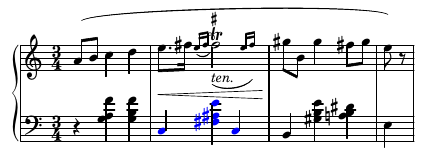Chopin's Mazurkas - Part 8
I only have a few weeks left before the end of the year, so I need to finish listening to the non-posthumous mazurkas or else I'll never forgive myself for being a quitter. I have 9 left. This week is Op. 56 and Op. 59. A double dose.
Trois Mazurkas
For à Mlle C. Maberly.
Op. 56, No. 1 in B major
The intro has some very strange modulation from B major to G major, and then eventually transitioning into the classic 7♭5 (one of my favorites from previous articles), which leads to F♯9 and then we're back in B. Nice. This is also a classic example of "tritone chord substitution" that jazz people will ramble on about as if it's some magical property beyond the realm of understanding unless you're teaching at Berklee. The real trick is to simply understand that (for example, in this particular excerpt) G7♭5 and C♯7♭5 contain all the same notes (enharmonically), which is why the "substitution" part works.
And then an awkward key change from B to E♭. I feel like there's some theory there, but I don't know what it is. Chopin did the same thing in the Finale of his 3rd Sonata, in the middle section I think.
The E♭ section is quite flighty and frivolous, and is later mimicked in the key of G.
Op. 56, No. 2 in C major
The main theme of this one is quite lame. Lots of block chords in the left hand and an incoherent melody. But the B section has a pretty sweet little countermelody to it.
Op. 56, No. 3 in C minor
This main theme sounds very familiar, like it was used in a movie or something.1
Eventually we get to something with a lot more accidentals. My score has a D♭7 with a C♭ on top which repeats itself with a B♮ in the next chord. The recording sounds different from what I have written, so that obviously warrants more investigation. But mostly I was reminded of Op. 24, No. 4 that had almost the same weird spelling and I hunted down the original manuscript to see what was what. From my brief research, the C♭ is pretty much never performed and is usually a C♮. The scores I found seemed to be about 50/50.
Some more fun enharmonic spelling in my score in the leadup back to the main theme, with a G♯ tied to an A♭. That kind of thing always amuses me.
Trois Mazurkas
Op. 59, No. 1 in A minor
More 7♭5 goodness in the A section, although it doesn't lead to anything that makes sense. But it wouldn't be a mazurka if it made sense.
The B section has some rather abrupt chord progressions. Definitely a mazurka.
Some mildly interesting RH-LH call/response things with lots of descending chromatics break up the monotony of confusing chord transitions.
And finally, I would never forgive myself if I didn't mention all the 7♭5 chords in the coda.
Op. 59, No. 2 in A♭ major
I kinda liked the little descending legato leading back to the main theme. Very Chopin-esque. The same little motif is repeated with a slightly different ending to lead-in to the C section.
A glut of chromatic accidentals prepares you for the coda.
Op. 59, No. 3 in F♯ minor
That B♯ in the first bar confused me, I had to listen to it
twice since it sounded so odd. Seems to just be passing tone, but it
definitely lends something exotic to the opening. And of course
everyone's favorite makes an appearance: the V of the V.
The triplets established by the theme make another appearance in the left-hand as we it takes us back to the main theme later in the piece.
Overall this one was okay. I liked the use of the lower register of the keyboard. Most of the mazurkas seem to remain in the middle.




















